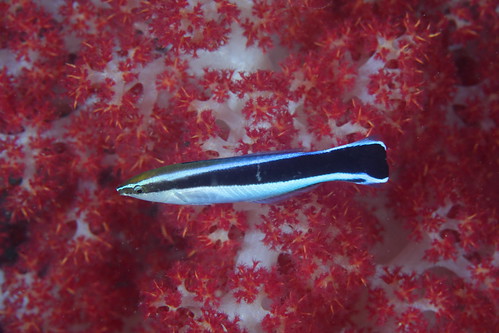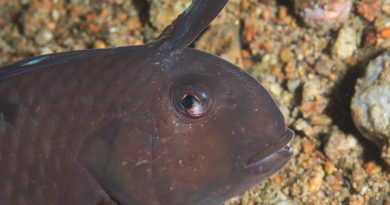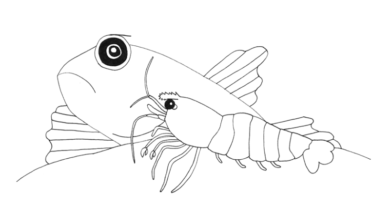Self Conscious Cleaner Wrasses
Cleaner Wrasses, Mirrors, and Mirror Neurons…
Recently, Masanori Kohda and colleagues published a clever scientific paper showing that cleaner wrasses, Labroides dimidatus, passed a test supposedly showing self-awareness. The paper is written in a very accessible style, something unfortunately not the case for a lot of the scientific literature, and while the authors describe some really interesting experiments in fish behavior, they are very careful with their conclusions. This care honors the scientist!
What is the mark-test or mirror-test? It’s a test to see if an animal is smart enough to realize that a reflection in a mirror is itself, not a person/fish/monkey/elephant of the same species, which lurks behind a plate of glass and dares to approach that animal exactly at the same time as the protagonist does.
Most humans can pass this test at age 1 1/2. Most.
In the hilarious autobiography of the late-yet-immortal Lemmy Klimister, he shares an anecdote where Motörhead’s original drummer, Phil “Philthy Animal” Taylor tried to climb out of a bathroom window – not realizing that it was in fact a bathroom mirror. To his defense, Philthy was seriously hammered at the time of the episode.
Not a lot of animal species have mastered this test. It needs serious cognitive capacities, and only a few mammals like great apes, elephants and dolphins have passed the mirror test, and some of the most intelligent birds, like crows. But now a fish also passed!
It’s not a surprise that Kohda and colleagues chose this cleaner fish for their study. These wrasses clean parasites off larger fishes, and there is a sophisticated communication system in place between the client and the cleaner. A jerking kind of dance by the cleaner wrasse signals the client fish that the cleaner is ready to go to work, and a combination of hovering, spreading fins and gill covers, and even color change (in goat fishes, for example) signal to the wrasse that a client is ready for a cleaning.
The cleaner wrasses are hence well versed in reading social signals from other fishes.
You can see a lot of this cleaning action on all of my cleaner wrasse shots on Flickr (click on the arrows on the edges to scroll through the album):
What Kohda and colleagues found was that when the cleaner wrasses first thought that the mirror image is another cleaner wrasse, and attacked it. That stopped after a few days, and the fish then started making unusual postures in front of the mirror, as if to check if the fish in the mirror would always do the same thing. Eventually, they seemingly realized that they were looking at themselves and “spent time in front of the mirror in non-aggressive postures while viewing the mirror image”.
When fish were marked with a dot akin to a piscine tattoo, they looked preferentially at that dot, and tried to rub it off, rubbing preferentially at the spot where they saw the tattooed color mark. Afterwards, they seemingly looked in the mirror at the spot on the body where the mark had been placed “in this case to check if the perceived parasite had been removed by the scraping attempt”.
It is not easy to interpret such sophisticated behavior by a fish, but to me it seems like a reasonable interpretation that the fish learned that the image they are looking at is themselves. This implies that they have at least a limited sense of self.
Mirror Neurons
An interesting body of work from neuroscience relevant to the mirror task are the recordings of mirror neurons. These neurons, initially described in the brains of macaque monkeys, are active when the monkey performs a certain task, like pointing upward and when the monkey sees another monkey doing the same action. These neurons are located in a specialized part of the monkey’s premotor cortex (the cortex tasked with planning motor programs).
A successful recognition of oneself in a mirror, so we can speculate, would mean that the mirror neurons are activated once by the animal’s own actions pre se, and once by the recognition of itself in the mirror.
Event though such a mirror neuron system has not been studied in cleaner wrasses yet, there is reason to believe that a system at least remotely similar would exist in fishes. There is no cerebral cortex akin to the cortex in the monkey brain in a bony fish brain – but fishes have complex brains, and large forebrains as well.
Isotocin
Another biological system highly relevant to cleaner wrasse behavior towards social mates or images of itself in a mirror are the nonapeptides. Among these is isotocin, the equivalent to the mammalian “love hormone” oxytocin. Isotocin is elevated in cleaner wrasse fore brains which encounter a client, but reduced in male wrasses when they encounter another (antagonistic) male. Hence the client-wrasse interaction is regulated on a cognitive-perceptual and on a hormonal level.
Here a cleaner wrasse is taking care of a couple of butterflyfish in Siquijor, Philippines:
References:
Kohda, Masanori, et al. “Cleaner wrasse pass the mark test. What are the implications for consciousness and self-awareness testing in animals?.” bioRxiv (2018): 397067.
Abreu, Murilo S., et al. “Nonapeptide levels in male cleaner fish’brains during interactions with unfamiliar intra and interspecific partners.” Behavioral Ecology and Sociobiology 72.7 (2018): 122.
Gallese, Vittorio, and Alvin Goldman. “Mirror neurons and the simulation theory of mind-reading.” Trends in cognitive sciences 2.12 (1998): 493-501.



